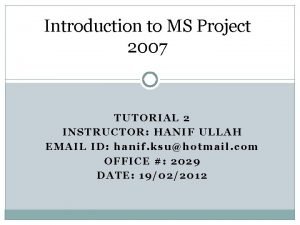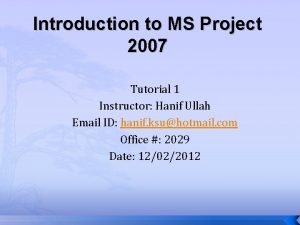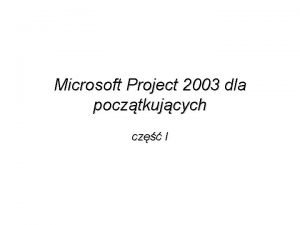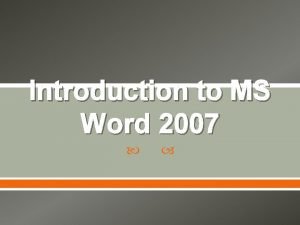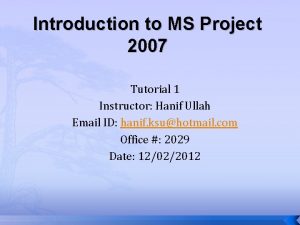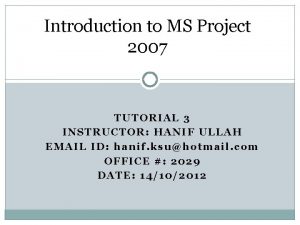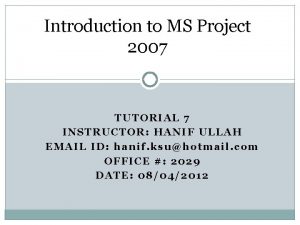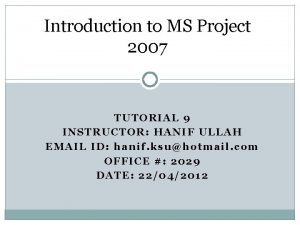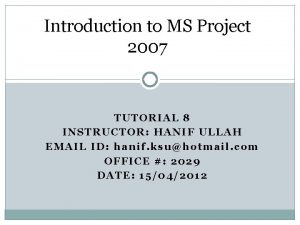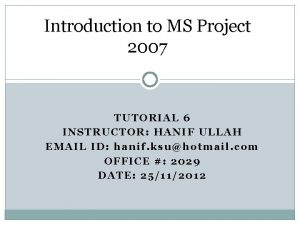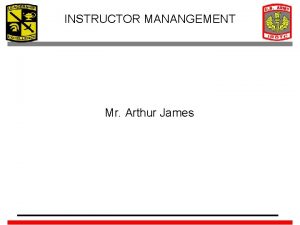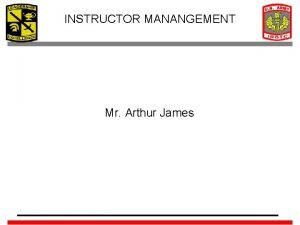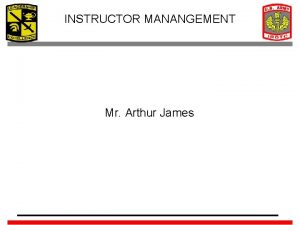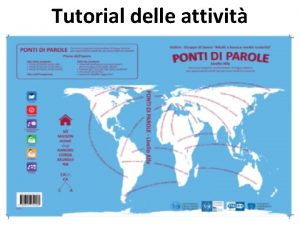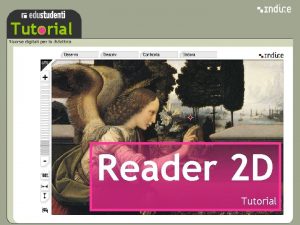Introduction to MS Project 2007 TUTORIAL 5 INSTRUCTOR















- Slides: 15

Introduction to MS Project 2007 TUTORIAL 5 INSTRUCTOR: HANIF ULLAH EMAIL ID: hanif. ksu@hotmail. com OFFICE #: 2029 DATE: 18/11/2012

Assigning Cost Resources to Tasks 2 � Cost resource costs, which are a fixed dollar amount that you enter when assigning the cost resource to a task. The amount is not affected by changes in duration or any other schedule changes to the task, although you can edit the amount at any time. � If task 4, Pick locations, is not already selected, click it the Task Name column. � In the Assign Resources dialog box, select the Cost field for the Travel cost resource. � Type 500, and then press Enter. � Task 4 now includes costs resulting from all three types of resource assignments: work, material, and cost. � Click the name of task 5, Hold auditions. � In the Assign Resources dialog box, select the Cost field for the Catering cost resource. � Type 250, and then click Assign. � Project assigns the cost resource to the task.

Assigning Material Resources to Tasks 2 �In this exercise, you assign the material resource Video Tape to a task and enter a fixed-unit quantity of consumption. �In the Task Name column, click the name of task 4, Pick locations. �You plan to use up to four tapes while picking locations. �In the Assign Resources dialog box, select the Units field for the Video Tape resource. �Type or select 4, and then press Enter. �Because video tape is a material resource, it cannot do work. Therefore, assigning a material resource does not affect the duration of a task.

Assigning Cost Resources to Tasks 4 � Cost resource costs, which are a fixed dollar amount that you enter when assigning the cost resource to a task. The amount is not affected by changes in duration or any other schedule changes to the task, although you can edit the amount at any time. � If task 4, Pick locations, is not already selected, click it the Task Name column. � In the Assign Resources dialog box, select the Cost field for the Travel cost resource. � Type 500, and then press Enter. � Task 4 now includes costs resulting from all three types of resource assignments: work, material, and cost. � Click the name of task 5, Hold auditions. � In the Assign Resources dialog box, select the Cost field for the Catering cost resource. � Type 250, and then click Assign. � Project assigns the cost resource to the task.

Formatting and Printing Your Plan 5 � Creating a Custom Gantt Chart View � In this exercise, you create a custom Gantt chart and apply predefined formatting to it using the Gantt Chart Wizard. You then preview the results for printing. � On the Tools menu, click Options. � In the Options dialog box, click the View tab. � Under the Outline options for label, select the Show project summary task check box, and then click OK. � Project displays the project summary task at the top of the Gantt Chart view. You might see pound signs (##) or only part of the value in the project summary task’s Duration field. If so, complete step 6. � Double-click the right edge of the Duration column in the column heading to expand the column so that you can see the entire value

Creating a Custom Gantt Chart View 6 �Next, you will create a copy of the Gantt Chart view so that the formatting changes you make will not affect the original Gantt Chart view. �On the View menu, click More Views. �The More Views dialog box appears, with the current view (the Gantt Chart view) selected. �Click the Copy button. �The View Definition dialog box appears. �In the Name field, type Custom Gantt Chart, and then click OK �In the More Views dialog box, click the Apply button. �On the Standard toolbar, click Scroll to Task.

Creating a Custom Gantt Chart View 7 � Next, you will use the Gantt Chart Wizard to format the Gantt bars and milestones in the chart portion of the Custom Gantt Chart view. � On the Format menu, click Gantt Chart Wizard. � The welcome page of the Gantt Chart Wizard appears � Click Next. � The next screen of the Gantt Chart Wizard appears. � Click Other, and on the drop-down list next to the Other option, click Standard: Style 4. � This is the only selection you’ll make in the Gantt Chart Wizard for now, so click the Finish button. � The final page of the Gantt Chart Wizard appears. � Click the Format It button, and then click the Exit Wizard button. � The Gantt Chart Wizard applies the Standard: Style 4 formatting to the Custom Gantt Chart view and then closes.

Creating a Custom Gantt Chart View 8 �Next, you will format an individual Gantt bar. You’d like to give more visual attention to the Gantt bar for the Hold auditions task. �Click the name of task 5, Hold auditions. �On the Format menu, click Bar. �On the Bar Shape tab, under Middle, click the Color box. �Click Blue, and then click OK. �On the File menu, click Print Preview �On the Print Preview toolbar, click Close

Drawing on a Gantt Chart 9 � Project includes a Drawing toolbar with which you can draw objects directly on the chart portion of a Gantt chart. For example, if you would like to note a particular event or graphically call out a specific item, you can draw objects, such as text boxes, arrows, and other items, directly on a Gantt chart. � In this exercise, you display the Drawing toolbar and add a text box to the Custom Gantt Chart view. � On the View menu, point to Toolbars, and then click Drawing. � On the Drawing toolbar, click the Text Box button, and then drag a small box anywhere on the chart portion of the Custom Gantt Chart view. � In the box that you just drew, type Film festival January 10 and 11 � On the Format menu, point to Drawing, and then click Properties. � The Format Drawing dialog box appears.

Drawing on a Gantt Chart 10 � Click the Line & Fill tab if it is not already selected. � In the Color box under the Fill label, click Yellow. � Next, you’ll attach the text box to a specific date on the timescale. � Click the Size & Position tab. � Make sure that Attach To Timescale is selected, and in the Date box, type or click 11/03/2012. � In the Vertical box under Attach To Timescale, type 2. 75 (this is the number of inches below the timescale where the top of the box will be positioned), and then click OK to close the Format Drawing dialog box. � Project colors the text box yellow and positions it below the timescale near the date you specified. � Click in an empty area of the Gantt Chart view to unselect the text box. � On the View menu, point to Toolbars, and then click Drawing.

Formatting Text in a View 11 � You can format text in tables, such as task names in a Gantt Chart view. � In this exercise, you switch to a different view and then use text styles and direct formatting to change the appearance of the text in that view. � On the View menu, click More Views. � In the Views box, click Task Sheet, and then click Apply. � On the View menu, point to Table: Entry, and then click Summary. � Next, you’ll change the way in which Project formats an entire category of information-in this case, summary tasks. � On the Format menu, click Text Styles. � On the Item to Change list, click Summary Tasks. � In the Size box, click 10.

Formatting Text in a View 12 �In the Color box, click Blue. �In the Background Color box, click Silver. �In the Background Pattern box, click the dark dot pattern at the bottom of the drop-down list. �Click OK. �In the Summary table, click the Cost field for task 7, the Production summary task. �On the Format menu, click Font. �In the Font Style box, click Bold Italic. �In the Background Color box, click Yellow. �Click OK.

Formatting and Printing Reports 13 �Reports are intended for printing Project data. �In this exercise, you view a report in the Print Preview window and then edit its format to include additional information. �On the Report menu, click Reports. �Click Overview, and then click the Select button. �In the Overview Reports dialog box, click Project Summary, and then click Select. �In the Print Preview window, click the upper half of the page with the mouse pointer. �On the Print Preview toolbar, click Close

Formatting and Printing Reports 14 �Next, you will preview and edit a different report. �Click Assignments, and then click Select. �In the Assignment Reports dialog box, click Who Does What When, and then click Select. �On the Print Preview toolbar, click the Multiple Pages button. �On the Print Preview toolbar, click the Page Setup button. �Click the Header tab. �On the Print Preview toolbar, click Close. �Click Close again to close the Reports dialog box. The Task Sheet view reappears.

15 END of Tutorial 5
 Project 2007 tutorial
Project 2007 tutorial Microsoft project 2007 tutorial
Microsoft project 2007 tutorial Office project 2007
Office project 2007 Ms office project 2007
Ms office project 2007 Ms project 2007
Ms project 2007 Microsotf word
Microsotf word Tipos de instructor
Tipos de instructor Basic instructor course tcole
Basic instructor course tcole Basic instructor course texas
Basic instructor course texas Basic instructor course tcole
Basic instructor course tcole Pepperball instructor course
Pepperball instructor course Not only the students but also the instructor
Not only the students but also the instructor Instructor vs teacher
Instructor vs teacher Ospfv
Ospfv Mptc firearms instructor manual
Mptc firearms instructor manual Basic instructor course #1014
Basic instructor course #1014
